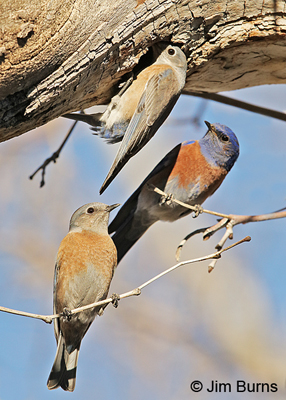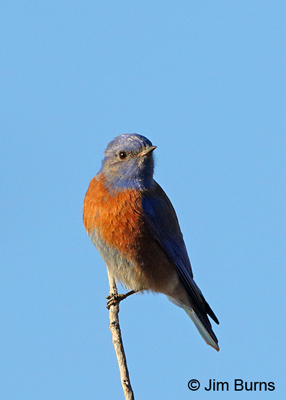
What are the Western Bluebirds in the opening frame actually doing? Good question. They’re probably not doing what it appears at first glance. Once again, photographing puzzling bird behavior led me to do a little investigative research on a species I had long taken for granted.
What we see in the photograph is a male and two females apparently investigating a tree cavity. What most birders probably know for sure is that bluebirds are cavity nesters, so it’s no leap of the imagination to figure these Westerns are prospecting for a nest hole prior to setting up housekeeping for breeding season. It seemed a bit odd, though, that there are three birds in the frame. Bluebirds are known to be monogamous, and they are not known to be social nesters, though on occasion a breeding pair may have a “nest helper” which is typically a male relative of the pair, frequently a juvenile from a previous nesting.
The birds in this photograph are clearly two adult females and one adult male. Here’s the critical piece of missing information about the photograph. It was taken on January 24. The birds were along a creek in the foothills of the Tonto National Forest. Even with the relatively mild winter which Arizona has enjoyed, late January is way early for Western Bluebird pair formation, and the Tonto foothills are a little low for this Ponderosa forest breeder. The earliest pair formation recorded in the mountain west for this species is mid-February, some pairs don’t hook up until mid-April, and mid-April is the earliest that eggs have been found.
Alright, so these bluebirds are still on their wintering grounds and the cavity, large enough to allow egress for more than one bird at a time, was in close proximity to berry laden Junipers along the creek which had large pools of standing water. I observed both males and females of this flock of about a dozen birds both entering and leaving the cavity with berries, and it appeared that the large host branch was rotted and probably hollowed out. Could this be a storage cavity with the whole flock helping to hoard a winter food supply? I could not recall anything in the literature indicating bluebirds cache their food.
At one point I observed three birds emerge from the cavity, one after the other in quick succession right after a male had delivered a berry. Research after the fact provided the elegant and obvious solution to the conundrum—outside of breeding season bluebirds roost together in large cavities for overnight warmth. Not surprising at all, but something heretofore unknown and unconsidered by this birder. Indeed, after the entire flock had breakfasted on berries they seemingly were sharing, they all dropped into the creek bed to drink, then departed over the hills for the rest of the morning.
Nature is one big biology lab. I’d encourage you to spend time in the field, unhurried and unhampered by trying to expand your eBird list for the day, observing and learning.
